Nature-Inspired Cloud–Crowd Computing for Intelligent Transportation System
Abstract
1. Introduction
- We offer an NIA method for generating efficient cycle schedules in a realistic urban environment (SUMO simulation network).
- Data from such a simulated network are stored in the cloud.
- Crowdsourcing and social media streams help update the cloud data.
- In case of any major event (accident, fire, etc.) that disrupts traffic flow, crowd data are provided, and updated information is stored in the cloud.
- Those about to take this affected route may change their direction after getting useful updates and can take another regular route to their destination.
2. Literature Survey
3. Problem Formulation and Technology
3.1. Nature-Inspired Algorithm (NIA)
3.2. SUMO Simulation
3.3. Traffic Simulations and Their Solution
3.4. Fitness Function
4. Methodology
5. Experimental Approach
5.1. Dataset
5.2. Experimental Setup
5.3. Results and Analysis
6. Conclusions
Author Contributions
Funding
Institutional Review Board Statement
Informed Consent Statement
Data Availability Statement
Conflicts of Interest
References
- Hurtado-Gómez, J.; Romo, J.D.; Salazar-Cabrera, R.; Pachón de la Cruz, Á.; Madrid Molina, J.M. Traffic Signal Control System Based on Intelligent Transportation System and Reinforcement Learning. Electronics 2021, 10, 2363. [Google Scholar] [CrossRef]
- Shawe-Taylor, J.; Bie, T.D.; Cristianini, N. Data mining, data fusion and information management. IEE Proc-Intell. Transp. Syst. 2006. [Google Scholar] [CrossRef]
- Zhang, J.; Wang, F.-Y.; Wang, K.; Lin, W.-H.; Xu, X.; Chen, C. Data-Driven Intelligent Transportation Systems: A Survey. IEEE Trans. Intell. Transp. Syst. 2011, 12, 1624–1639. [Google Scholar] [CrossRef]
- Nair, D.J.; Gilles, F.; Chand, S.; Saxena, N.; Dixit, V. Characterizing multicity urban traffic conditions using crowdsourced data. PLoS ONE 2019, 14, e0212845. [Google Scholar]
- Srivastava, S.; Sahana, S.K. Application of Bat Algorithm for Transport Network Design Problem. Appl. Comput. Intell. Soft Comput. 2019, 2019, 1–12. [Google Scholar] [CrossRef]
- Dobrota, N.; Stevanovic, A.; Mitrovic, N. Development of Assessment Tool and Overview of Adaptive Traffic Control Deployments in the U.S. Transp. Res. Rec. J. Transp. Res. Board 2020, 2674, 464–480. [Google Scholar] [CrossRef]
- Garcia-Nieto, J.; Olivera, A.C.; Alba, E. Optimal Cycle Program of Traffic Lights with Particle Swarm Optimization. IEEE Trans. Evol. Comput. 2013, 17, 823–839. [Google Scholar] [CrossRef]
- Jovanović, A.; Stevanović, A.; Dobrota, N.; Teodorović, D. Ecology based network traffic control: A bee colony optimization approach. Eng. Appl. Artif. Intell. 2022, 115, 105262. [Google Scholar] [CrossRef]
- Mohamed, S.A.E.; AlShalfan, K.A. Intelligent Traffic Management System Based on the Internet of Vehicles (IoV). J. Adv. Transp. 2021, 2021, 1–23. [Google Scholar] [CrossRef]
- Shi, Y.; Qi, Y.; Lv, L.; Liang, D. A Particle Swarm Optimisation with Linearly Decreasing Weight for Real-Time Traffic Signal Control. Machines 2021, 9, 280. [Google Scholar] [CrossRef]
- Mohamed, N.E.; Radwan, I.I. Traffic light control design approaches: A systematic literature review. Int. J. Electr. Comput. Eng. 2022, 12, 5355–5363. [Google Scholar] [CrossRef]
- Nagy, J.; Lakatos, I. Possibilities of Using Online Vehicle Diagnostics in the Future. In Vehicle and Automotive Engineering 4. VAE 2022. Lecture Notes in Mechanical Engineering; Jármai, K., Cservenák, Á., Eds.; Springer: Cham, Switzerland, 2022. [Google Scholar] [CrossRef]
- Lakatos, I.; Szauter, F.; Pup, D.; Nagy, A. Alternative Propulsion Buses in the Metropolitan Public Transport. In Vehicle and Automotive Engineering 3. VAE 2020. Lecture Notes in Mechanical Engineering; Jármai, K., Voith, K., Eds.; Springer: Singapore, 2021. [Google Scholar] [CrossRef]
- Péter, T.; Szauter, F.; Rózsás, Z.; Lakatos, I. Integrated application of network traffic and intelligent driver models in the test laboratory analysis of autonomous vehicles and electric vehicles. Int. J. Heavy Veh. Syst. 2020, 27, 227–245. [Google Scholar] [CrossRef]
- Lin, H.; Han, Y.; Cai, W.; Jin, B. Traffic Signal Optimization Based on Fuzzy Control and Differential Evolution Algorithm. IEEE Trans. Intell. Transp. Syst. 2022, 1–12. [Google Scholar] [CrossRef]
- Hosseinzadeh, M.; Sinopoli, B.; Kolmanovsky, I.; Baruah, S. MPC-Based Emergency Vehicle-Centered Multi-Intersection Traffic Control. IEEE Trans. Control Syst. Technol. 2022, 1–13. [Google Scholar] [CrossRef]
- Jia, H.; Lin, Y.; Luo, Q.; Li, Y.; Miao, H. Multi-objective optimization of urban road intersection signal timing based on particle swarm optimization algorithm. Adv. Mech. Eng. 2019, 11, 1687814019842498. [Google Scholar] [CrossRef]
- Le, T.; Kovács, P.; Walton, N.; Vu, H.L.; Andrew, L.L.; Hoogendoorn, S.S. Decentralized signal control for urban road networks. Transp. Res. Part C Emerg. Technol. 2015, 58, 431–450. [Google Scholar] [CrossRef]
- Eom, M.; Kim, B.-I. The traffic signal control problem for intersections: A review. Eur. Transp. Res. Rev. 2020, 12, 1–20. [Google Scholar] [CrossRef]
- Le, T.; Vu, H.L.; Walton, N.; Hoogendoorn, S.P.; Kovács, P.; Queija, R.N. Utility optimization framework for a distributed traffic control of urban road networks. Transp. Res. Part B Methodol. 2017, 105, 539–558. [Google Scholar] [CrossRef]
- Younes, M.B.; Boukerche, A. Intelligent Traffic Light Controlling Algorithms Using Vehicular Networks. IEEE Trans. Veh. Technol. 2015, 65, 5887–5899. [Google Scholar] [CrossRef]
- Hunt, P.B.; Robertson, D.I.; Bretherton, R.D.; Winton, R.I. SCOOT—A Traffic Responsive Method of Coordinating Signals; No. LR 1014 Monograph; Transport and Road Research Laboratory (TRRL): Berkshire, UK, 1981. [Google Scholar]
- Sims, A.G. The Sydney coordinated adaptive traffic system. In Engineering Foundation Conference on Research Directions in Computer Control of Urban Traffic Systems; SCAT: Pacific Grove, CA, USA, 1979. [Google Scholar]
- Gartner, N.H. OPAC: A Demand-Responsive Strategy for Traffic Signal Control (No. 906); Transport and Road Research Laboratory (TRRL): Berkshire, UK, 1983. [Google Scholar]
- Mirchandani, P.; Head, L. A real-time traffic signal control system: Architecture, algorithms, and analysis. Transp. Res. Part C Emerg. Technol. 2001, 9, 415–432. [Google Scholar] [CrossRef]
- Tassiulas, L.; Ephremides, A. Stability properties of constrained queueing systems and scheduling policies for maximum throughput in multihop radio networks. In Proceedings of the 29th IEEE Conference on Decision and Control, Honolulu, HI, USA, 5–7 December 1990; pp. 2130–2132. [Google Scholar]
- Weerasundara WA, G.; Udugahapattuwa DP, D.; Munasingha, T.D.; Gunathilake WD, K.; Dampage, E. An Adaptive and Coordinated Traffic Signal Scheme for Greener Transport 4.0. In Proceedings of the International Conference on Electrical and Electronics Engineering, Virtual, 27–18 August 2022; pp. 206–217. [Google Scholar]
- Wongpiromsarn, T.; Uthaicharoenpong, T.; Wang, Y.; Frazzoli, E.; Wang, D. Distributed traffic signal control for maximum network throughput. In Proceedings of the 2012 15th International IEEE Conference on Intelligent Transportation Systems, Anchorage, AK, USA, 16–19 September 2012; pp. 588–595. [Google Scholar]
- Gregoire, J.; Samaranayake, S.; Frazzoli, E. Back-pressure traffic signal control with partial routing control. In Proceedings of the 2016 IEEE 55th Conference on Decision and Control (CDC), Las Vegas, NV, USA, 12–14 December 2016; pp. 6753–6758. [Google Scholar]
- Wu, J.; Ghosal, D.; Zhang, M.; Chuah, C.-N. Delay-Based Traffic Signal Control for Throughput Optimality and Fairness at an Isolated Intersection. IEEE Trans. Veh. Technol. 2017, 67, 896–909. [Google Scholar] [CrossRef]
- Dobrota, N.; Stevanovic, A.; Mitrovic, N. Modifying Signal Retiming Procedures and Policies by Utilizing High-Fidelity Modeling with Medium-Resolution Traffic Data. Transp. Res. Rec. J. Transp. Res. Board 2021, 2676, 660–684. [Google Scholar] [CrossRef]
- Srivastava, S.; Sahana, S.K. A survey on traffic optimization problem using biologically inspired techniques. Nat. Comput. 2019, 19, 647–661. [Google Scholar] [CrossRef]
- Krajzewicz, D.; Bonert, M.; Wagner, P. The Open Source Traffic Simulation Package SUMO; RoboCup: Bordeaux, France, 2006. [Google Scholar]
- Haklay, M.; Weber, P. OpenStreetMap: User-Generated Street Maps. IEEE Pervasive Comput. 2008, 7, 12–18. [Google Scholar] [CrossRef]
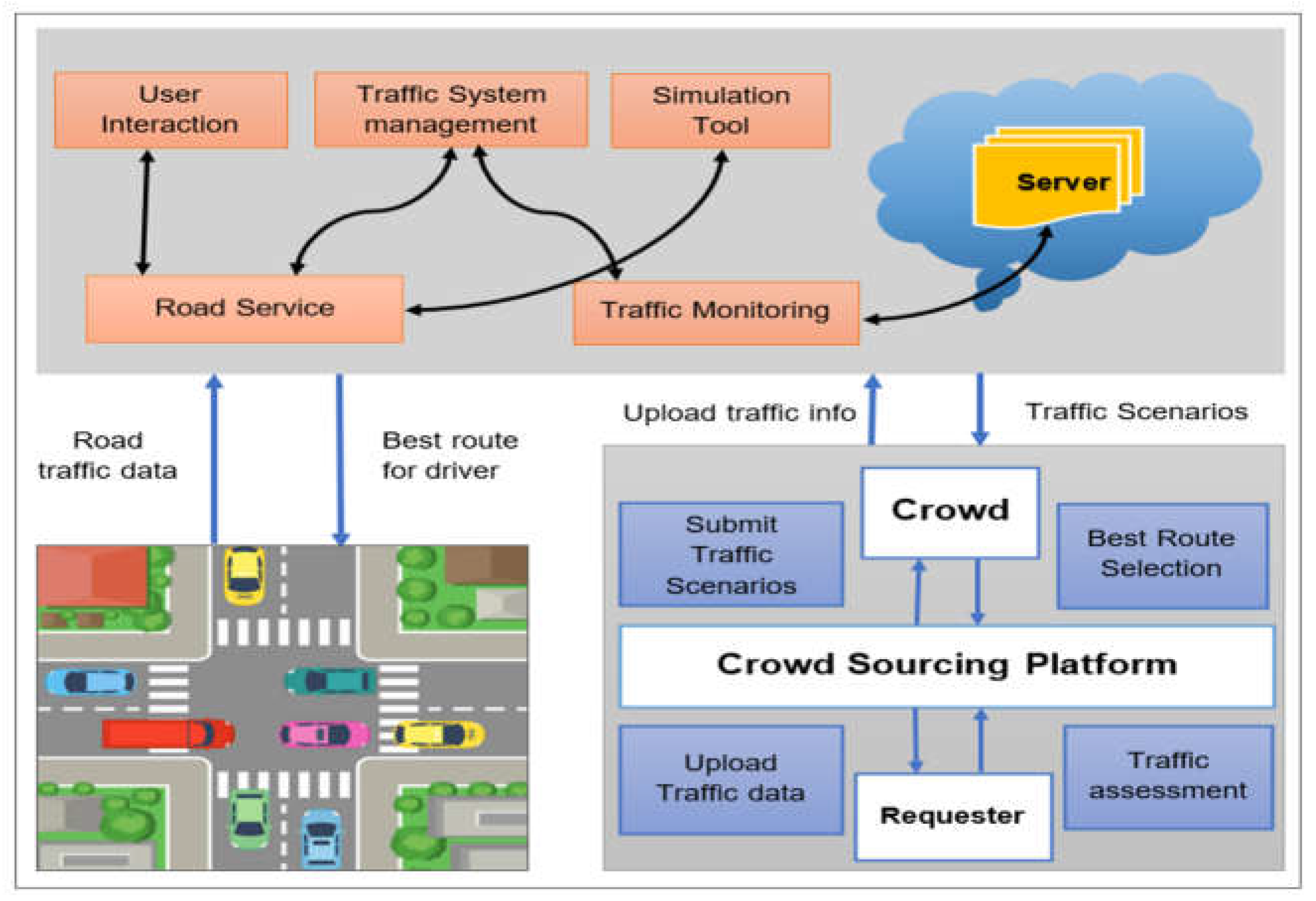
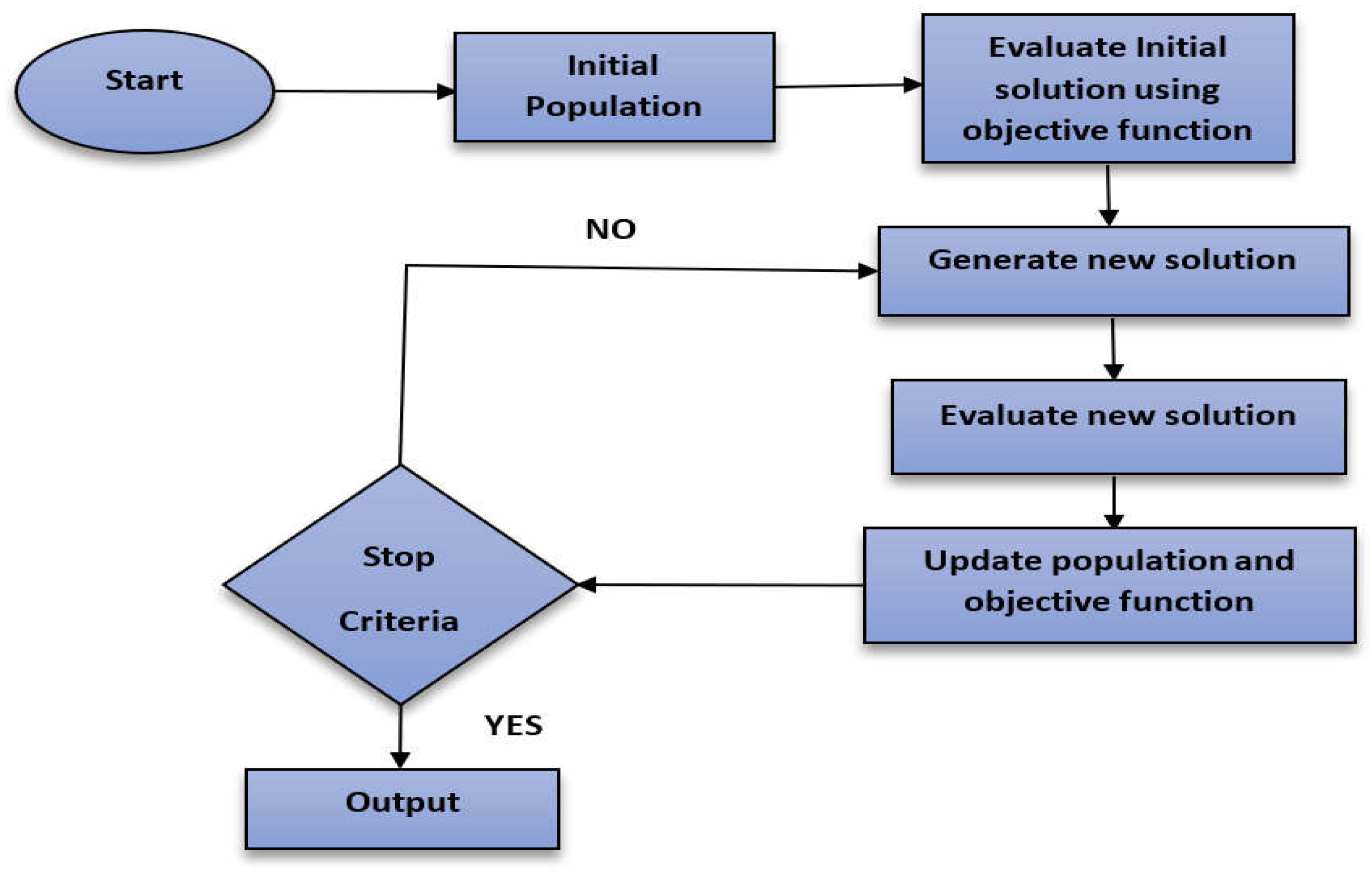
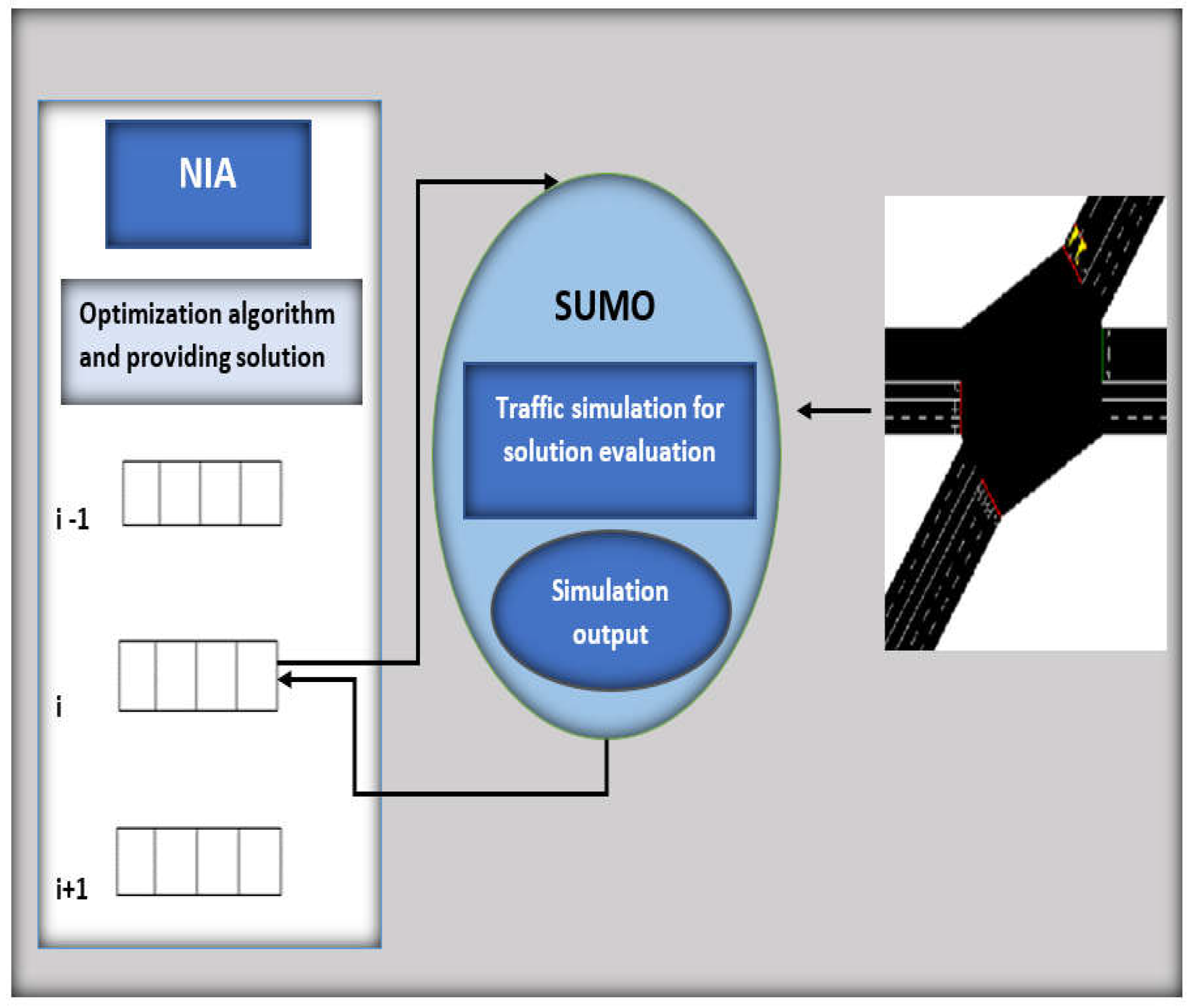

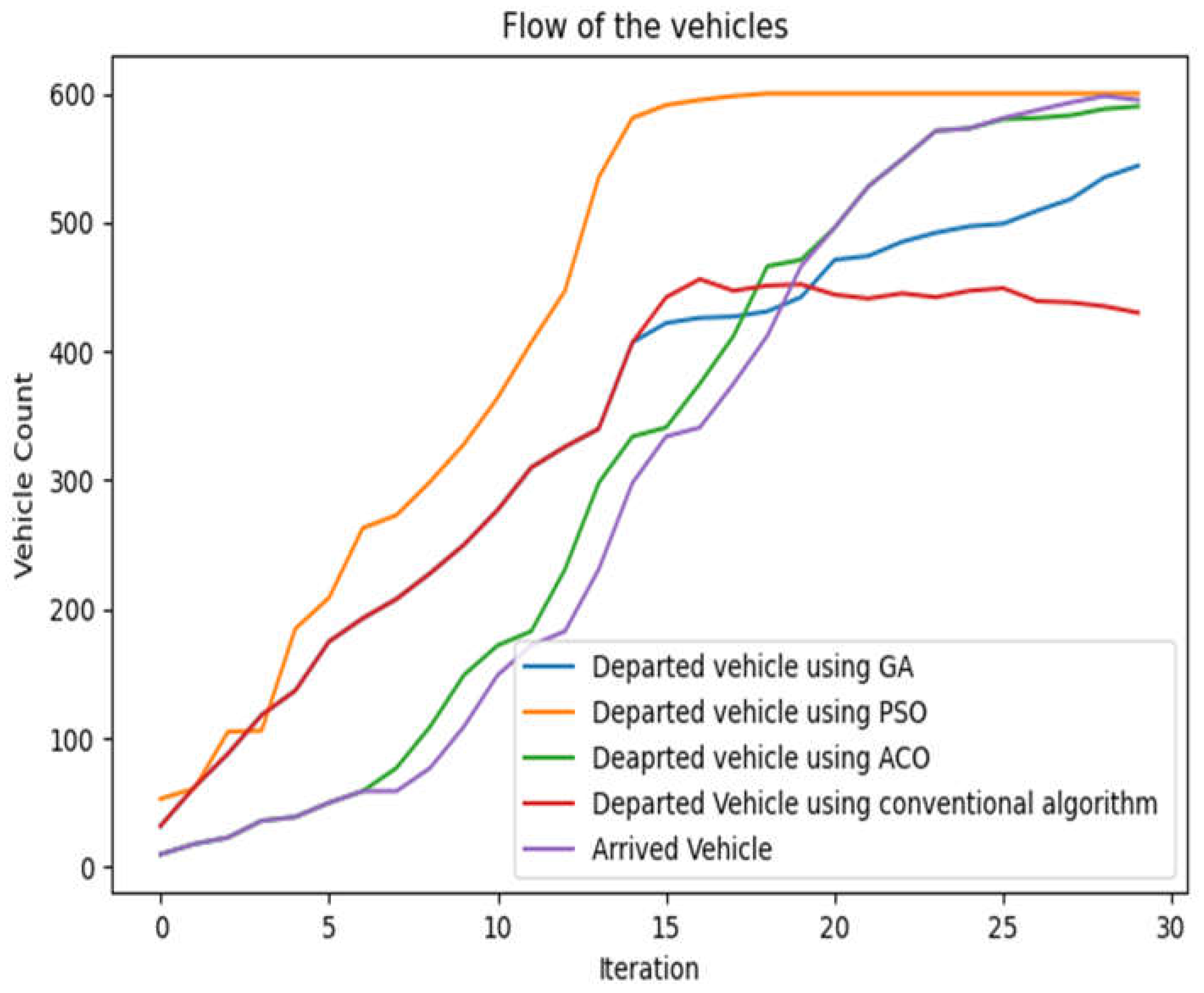

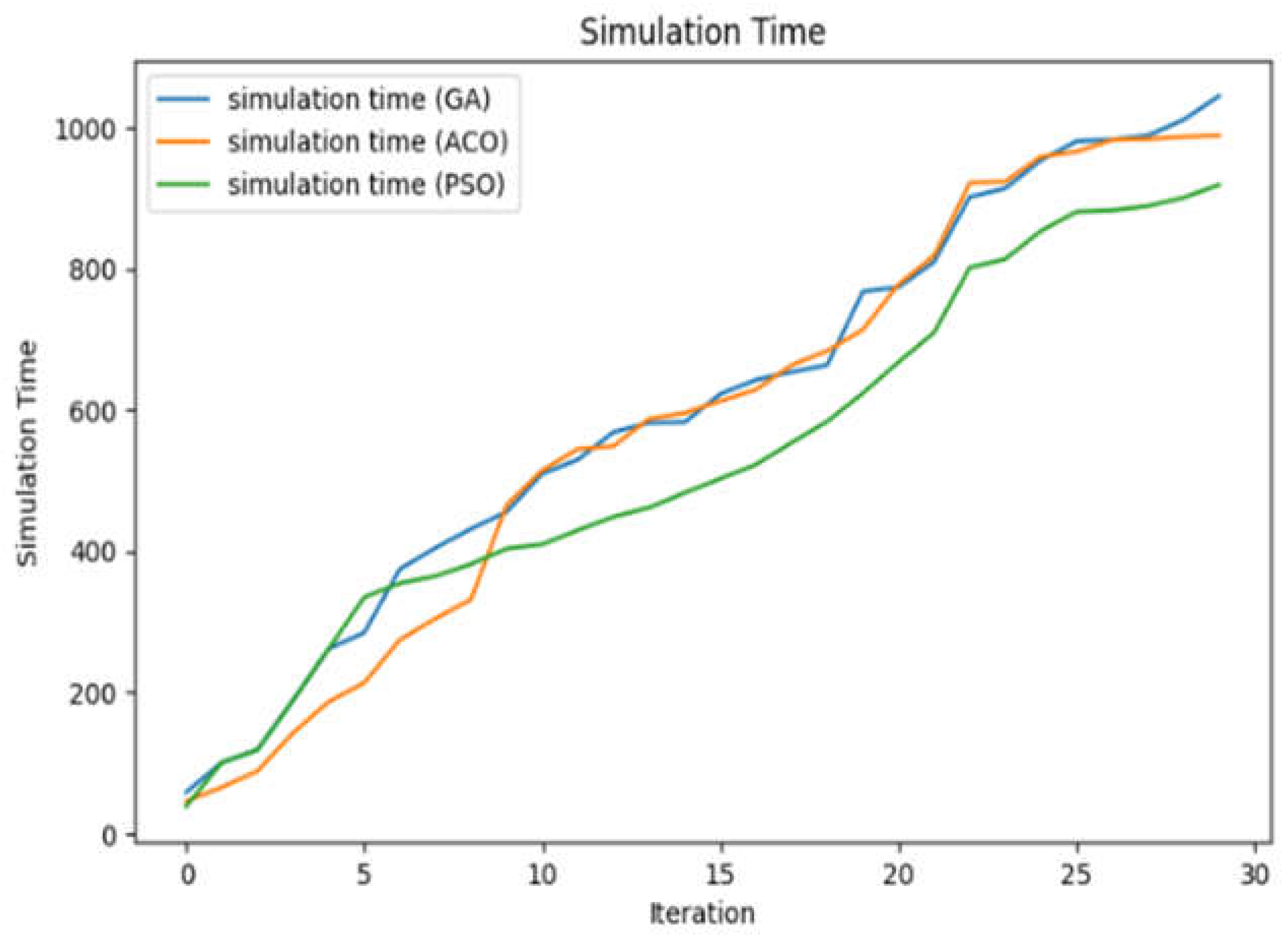
| Iteration | PSO | ACO | GA | ||||||
|---|---|---|---|---|---|---|---|---|---|
| ST | VC | FV | ST | VC | FT | ST | VC | FV | |
| 1 | 39 | 53 | 1480.99 | 46 | 10 | 1320.92 | 59 | 32 | 1220.99 |
| 2 | 101 | 61 | 1410.07 | 66 | 18 | 1210.17 | 101 | 62 | 1010.07 |
| 3 | 119 | 105 | 1029.05 | 89 | 23 | 959.05 | 119 | 88 | 929.05 |
| 4 | 189 | 106 | 910.12 | 143 | 36 | 810.11 | 189 | 118 | 710.12 |
| 5 | 262 | 185 | 735.17 | 187 | 39 | 605.17 | 262 | 137 | 635.14 |
| 6 | 385 | 209 | 635.01 | 214 | 50 | 495.12 | 285 | 175 | 435.02 |
| 7 | 355 | 263 | 525.11 | 275 | 59 | 385.19 | 375 | 193 | 325.11 |
| 8 | 365 | 273 | 425.18 | 305 | 77 | 224.82 | 405 | 208 | 325.13 |
| 9 | 382 | 299 | 324.72 | 332 | 109 | 282.14 | 432 | 228 | 324.72 |
| 10 | 404 | 328 | 282.11 | 466 | 149 | 185.95 | 456 | 250 | 222,11 |
| 11 | 410 | 364 | 195.45 | 515 | 172 | 178.34 | 510 | 277 | 115.45 |
| 12 | 430 | 407 | 188.34 | 545 | 183 | 112.28 | 530 | 310 | 118.34 |
| 13 | 449 | 447 | 170.88 | 549 | 231 | 108.08 | 569 | 326 | 110.88 |
| 14 | 462 | 535 | 160.87 | 588 | 298 | 73.89 | 582 | 340 | 110.07 |
| 15 | 483 | 581 | 89.69 | 596 | 334 | 76.17 | 583 | 407 | 83.69 |
| 16 | 503 | 591 | 71.17 | 613 | 341 | 75.03 | 643 | 422 | 77.37 |
| 17 | 523 | 595 | 65.03 | 629 | 375 | 69.98 | 654 | 426 | 75.03 |
| 18 | 654 | 598 | 58.78 | 664 | 412 | 59.77 | 674 | 427 | 68.78 |
| 19 | 584 | 600 | 49.08 | 684 | 466 | 49.18 | 724 | 431 | 59.02 |
| 20 | 624 | 600 | 35.28 | 714 | 471 | 38.69 | 768 | 442 | 45.78 |
| 21 | 668 | 600 | 31.11 | 778 | 496 | 26.72 | 774 | 471 | 33.59 |
| 22 | 710 | 600 | 17.05 | 819 | 528 | 17.49 | 810 | 474 | 16.02 |
| 23 | 802 | 600 | 15.39 | 922 | 549 | 11.03 | 902 | 485 | 19.69 |
| 24 | 814 | 600 | 11.08 | 924 | 571 | 10.48 | 914 | 492 | 4.03 |
| 25 | 854 | 600 | 12.78 | 959 | 573 | 9.58 | 954 | 497 | 15.48 |
| 26 | 881 | 600 | 11.78 | 966 | 580 | 8.62 | 981 | 499 | 10.98 |
| 27 | 883 | 600 | 10.92 | 983 | 581 | 7.54 | 983 | 509 | 10.02 |
| 28 | 889 | 600 | 9.64 | 984 | 583 | 8.68 | 989 | 518 | 13.24 |
| 29 | 901 | 600 | 8.68 | 987 | 588 | 6.38 | 1011 | 535 | 15.48 |
| 30 | 919 | 600 | 6.57 | 989 | 590 | 5.78 | 1045 | 544 | 10.98 |
Publisher’s Note: MDPI stays neutral with regard to jurisdictional claims in published maps and institutional affiliations. |
© 2022 by the authors. Licensee MDPI, Basel, Switzerland. This article is an open access article distributed under the terms and conditions of the Creative Commons Attribution (CC BY) license (https://creativecommons.org/licenses/by/4.0/).
Share and Cite
Singh, V.; Sahana, S.K.; Bhattacharjee, V. Nature-Inspired Cloud–Crowd Computing for Intelligent Transportation System. Sustainability 2022, 14, 16322. https://doi.org/10.3390/su142316322
Singh V, Sahana SK, Bhattacharjee V. Nature-Inspired Cloud–Crowd Computing for Intelligent Transportation System. Sustainability. 2022; 14(23):16322. https://doi.org/10.3390/su142316322
Chicago/Turabian StyleSingh, Vandana, Sudip Kumar Sahana, and Vandana Bhattacharjee. 2022. "Nature-Inspired Cloud–Crowd Computing for Intelligent Transportation System" Sustainability 14, no. 23: 16322. https://doi.org/10.3390/su142316322
APA StyleSingh, V., Sahana, S. K., & Bhattacharjee, V. (2022). Nature-Inspired Cloud–Crowd Computing for Intelligent Transportation System. Sustainability, 14(23), 16322. https://doi.org/10.3390/su142316322







